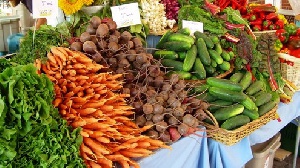Prices of most basic foodstuffs have shot up drastically over the last one year.
The prices of some of the foodstuffs have risen as much as 50% from January 2015 to date.
A market survey conducted by The Finder at major markets in Accra revealed significant hikes in prices of foodstuffs such as vegetables, tubers, cereals, and canned and frozen foods.
At the Agbogbloshie market, this paper gathered that a sack of maize, which used to sell at GHC140 as of January last year, now sells at GHC220 while an ‘olonka’ of gari sells at GHC6.50; it was sold at GHC3.50 a year ago.
The price of beans depends on the country of origin. A cup of beans from Ghana, Nigeria and Togo now sells at GHC7, GHC12 and GHC8.50 respectively.
Previously, the same item sold at GHC5, GHC10 and GHC6 respectively.
A medium tuber of yam (Puna) now sells at GHC5, as against GHC3 in January 2015.
For plantain, five fingers now sell for GHC5, compared to GHC3 this time last year.
Sugar, a common commodity consumed in many homes, now sells at ?1.60 per cup, as against GHC1.20 last year January.
At the Makola Market, cow feet, popularly called ‘Kotodwe,’ now sells between GHC20 and GHC25 depending on the size, almost double the ?12 to ?15 it was sold for in January 2015.
Another important food commodity, tomato now sells at ?15 per small paint bucket, instead of GHC12 in January last year.
The price of a tin of milk jumped from GHC2 to GHC2.50 within the year while 1 litre of cooking oil, which was GHC7 last year January, is now selling at GHC8.50.
The price of a carton of frozen chicken thigh rose from ?75 as of January 2015 to a current price of GHC110 while a carton of frozen chicken thigh (hard) increased from GHC95 to GHC120.
A medium size loaf of bread that was selling at ?5 last year is now going for ?7.
A carton of frozen fish has increased from GHC230 to GHC300 within the one year period while a pound of salted beef, which was selling at GHC12, now sells at GHC15.
The price, of one bar of Key Soap jumped' from GHC3.80 in January last year to the current price of GHC6.
Some of the traders The Finder spoke to attributed the increases to the recent hikes in fuel prices and utility tariffs.
They were, however, of the view that customers would soon understand the adjustment as it is no fault of theirs.
Customers, on the other hand, are complaining about hard times, but remain hopeful that the trend of frequent hikes would slow down to enable them survive.
January inflation rate rises sharply to 19%.
The Public Utilities Regulatory Commission in December announced a 59.2 per cent increase in electricity tariff while water went up to about 89 per cent. In January, fuel prices also went up by 27 per cent.
The monthly change rate for January 2016 was 4.6 per cent, compared to the December change of 1.1 per cent.
The food inflation, rate for January was 8.2 per cent, slightly up from the 8.0 per cent recorded in December 2015.
On the other hand, the non-food inflation rate for January stood at 25.5 percent from 23.3 percent in December 2015.
“The non-food inflation rate (25.5%) is, more than three times higher than the food inflation rate (8.2%).”
The inflation rate for imported items was 18.7 per dent in January 2016, compared to 18.3 per cent in December, while that of locally produced items was 19.1 per cent versus 17.5 per cent for the same, period.
The main “price drivers” for the non-food inflation rate were housing, water, electricity, gas and other fuels, contributing about 45.5 per cent, while transport added 30.8 per cent.
The “price drivers” for the food inflation rate were coffee, tea and cocoa, mineral water, soft drinks, fruit and vegetable juices, sugar, jam, honey, chocolate and confectionery, food products and vegetables.
Two regions (Ashanti and Greater Accra) recorded inflation fates higher than the national average of 19.0 per cent.
The greater Accra Region recorded the highest year-on-year inflation, rate of 23.1 per cent while the Upper East Region recorded, the lowest of 14.1 per cent.
Click to view details



Business News of Wednesday, 9 March 2016
Source: The Finder
Food prices soar by 50%
Entertainment
















